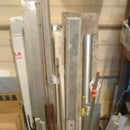Introduction: C-Mount Web Cam Mod
Use PVC pipe as the case. I turned a recess to accept an EOS-C adapter from Amazon ($3)
Step 1: Details to Mount the CMOS
I used a piece of dowel ( could be aluminum rod just as well ) It holds two screws that both mount the camera board and provide focus adjustment.
Step 2: Photos of Project
Top: Base components for case. Piece of 2" PVC, the adapter and a standard 16mm lens.
Second from top: Detail of turned recess to fit adapter.
Third from top: Assembled rear view showing mounting post ( fancy word for dowel !)
Bottom: Shown with Sony 16-75 MM CCTV lens.
Step 3: Sample Image
This is a crappy image. Actual view on screen is better but the CPU I was using did not have graphics program installed yet so I took picture from screen using my phone. At least it gives some idea of the range of camera/lens combo. This is the Sony 16-75mm lens at max zoom.
Step 4: Step by Step ( Sorta )
I decided that having a collection of nice legacy c-mount TV lenses gathering dust was a shame. These came from various decent video cameras of old. VHS, Beta, StoneTablet. What ever.
While there are commercial c-mount USB cameras available, sold mostly for microscope use or machine intelligence. Cost too much just to justify playing around.
I had this el-cheepo $12 web cam so thought I'd sacrifice that to the cause.
2" PVC pipe for the body and ordered a $3 EOS to C adapter from Amazon and went to work.
I cut a piece of pipe about 2" long. In order to fit the adapter into the end I turned a bit of a recess in one end. You could probably find another way to do this if you don't have a lathe handy. Perhaps a slice of coupling or even use a coupling for housing which should accommodate the adapter.
I drilled and tapped holes. Three for set screws to hold the adapter, two (top and bottom) 1/4-20 for tripod mount so it could be positioned from above or below.
The camera board is about 1.25" square with the CMOS chip on center which was what I hoped for with the round camera. If you try using a rectangular camera with offset lens you may need to consider other mounting options.
A piece of 3/16 acrylic scrap cut to a square holds the board behind the lens by about 1/2". I drilled and tapped two 6-32 holes on the acrylic's edges for mounting/focus screws.
Two 1/4" holes and a piece of 1/4" dowel serve as mounting post. This runs side to side with two holes that align with the holes in the acrylic.
Two 6-32 screws pass through small coil sprints into the tapped holes in the acrylic mount to provide position control to adjust focus for the lens.
A 2" pvc test cap will serve as the back cover. Easy to remove to access focus screws.
While the quality of the camera is not that exceptional, the concept works quite well and given the small surface area of cheap web cams, even a basic 16mm TV lens is telephoto. A Sony Zoom lens is phenomenal at distance. I settled on a 12.5mm Cosmicar lens from my collection and that provides for a very nice image format.
If I were to buy a higher quality HD web cam I am sure this could result in a very nice, c-Mount web cam setup.





